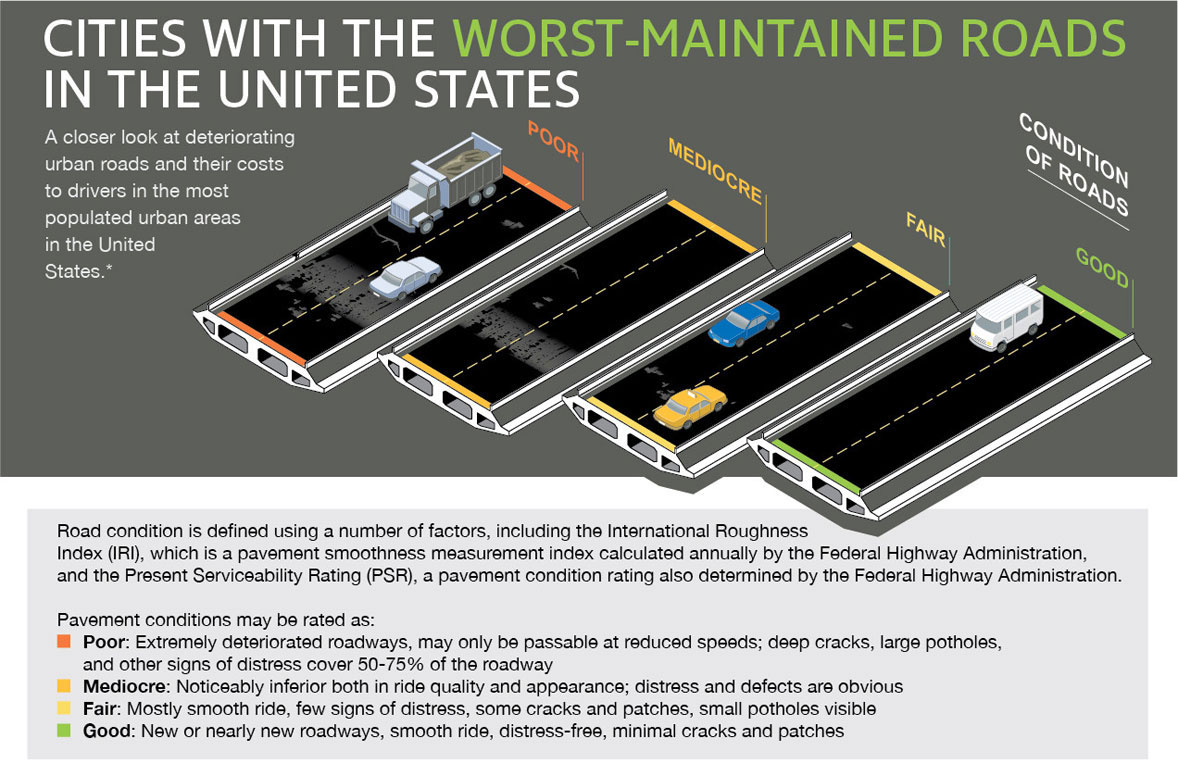Does your city have the worst roads in America?
Ah, a favorite topic amongst just about everyone here in the greater Detroit area: how absolutely terrible the roads are. But decaying road quality affects people across the United States, and not just through inconvenience, discomfort, or unsightliness. Poor road quality also means increased maintenance and repair costs, whether in the form of flat tires, bent wheels, or damaged suspension components.
Teletrac Navman, a software company that specializes in fleet and asset management, recently put together a list of the country’s worst-maintained roads based on data from a national transportation non-profit research group called TRIP. Using a metric called the International Roughness Index, TRIP sorted road conditions into four categories (Poor, Mediocre, Fair, and Good) and Teletrac Navman mapped the roads in major U.S. urban areas to determine which cities had the highest (and lowest) percentage of Poor-condition roads.

By a fairly wide margin, roads in California’s Bay Area (San Francisco-Oakland) are in the worst shape. Why so bad in the Bay Area? The report indicates that roads in this region are built atop sandy dunes, and buckled roads from frequent earthquakes don’t help, not to mention very low infrastructure funding. Poor-condition roads make up a brutal 71 percent of roads in the Bay Area, and only 8 percent can be called Good. Los Angeles is not far behind with 60 percent Poor roads, followed by San Jose and Detroit at 59 percent and 56 percent, respectively. Here’s a list of the 10 urban areas with the highest percentage of Poor roads:
- San Francisco-Oakland (71 percent)
- Los Angeles (60 percent)
- San Jose, Calif. (59 percent)
- Detroit (56 percent)
- Milwaukee (56 percent)
- Bridgeport-Stamford, Conn. (55 percent)
- Omaha, Neb.-Iowa (54 percent)
- Oklahoma City (53 percent)
- Grand Rapids, Mich. (52 percent)
- Tulsa, Okla. (49 percent)
It’s an especially tough break for Oklahoma—while Oklahoma City and Tulsa occupy the eighth and 10th spot on this list, people in those cities pay the most when it comes to additional annual maintenance and repair costs. On average, Oklahoma City residents pay $1025 and Tulsans pay $998.

Overall, 32 percent of American urban roads are in “unacceptable condition,” the report says. The degradation is the result of increased population and vehicle usage, poor pavement material choices in high-moisture areas, deferred regular maintenance, and ineffective patching.
Syracuse, New York (not classified at an urban center on this list), is a model city for how to effectively combat these trends, even with its famously heavy snowfall and large reliance on salt. Although only 40 percent of its roads are in Good condition, its residents spend the least on average for additional vehicle maintenance and repair of any city in the country. That isn’t because it has a huge budget either—the trick seems to be using data collection to approach the problem rather than relying on the volume of complaints from residents. Nearby Rochester and Buffalo have a similarly high percentage of Good roads and low percentage of Poor roads.

So where are the best roads in the country? Not surprisingly, they’re in more southern urban areas that don’t have to reckon with winter weather. A whopping 65 percent of roads in the Nashville-Davidson, Tennessee, and Orlando areas are Good. Jacksonville isn’t far behind at 61 percent, and McAllen, Texas, is next at 55 percent. Somehow the Providence, Rhode Island-Massachusetts, urban area made it too, with 43 percent of its roads qualifying as Good and just 22 percent rated as Poor.
So next time you want to gripe over just how bad the roads are, remember there is probably somewhere that has it worse. And if you’re high on the bad road list like I am in the Detroit area, you can feel justified to complain your lungs out.



